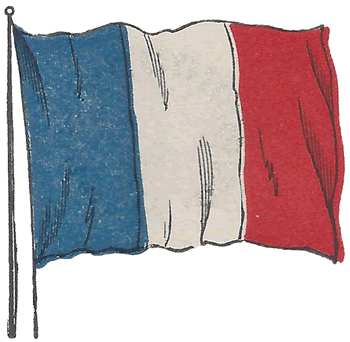| French National Flag |
|---|
| www.studenthandouts.com ↣ Geography ↣ Europe ↣ Western Europe ↣ France |
 The tricolor flag of France became the official French Republic flag following the French Revolution of 1789. It was briefly replaced by the Bourbon flag following the defeat of Napoleon Bonaparte. Today, the tricolor is the official flag of not only France, but many of its territories around the world.
The tricolor flag of France became the official French Republic flag following the French Revolution of 1789. It was briefly replaced by the Bourbon flag following the defeat of Napoleon Bonaparte. Today, the tricolor is the official flag of not only France, but many of its territories around the world. The origins of the French flag, known as the Tricolore, date back to the late 18th century during the French Revolution, a period marked by profound social, political, and cultural upheaval. The flag's design consists of three vertical stripes of equal width, colored blue, white, and red from left to right. The Tricolore was first adopted in 1790 as a symbol of the revolution and the new principles of liberty, equality, and fraternity. Its colors were inspired by the cockades, or badges, worn by revolutionaries. The blue and red colors were taken from the traditional colors of Paris, symbolizing the city's role in the revolution. These colors had been used by the Paris militia and were prominently displayed during the storming of the Bastille on July 14, 1789, a key event in the revolution. The white stripe, placed between the blue and red, was added to symbolize the French monarchy, thus representing the unity between the revolution and the old order. White had historically been associated with the Bourbon dynasty and was considered a symbol of the nation.  The Tricolore became an official national symbol with the adoption of the First Republic in 1792. It represented the values of the revolution and the unity of the French people under a single, national identity. Despite changes in government and regime, the flag endured as a powerful symbol of the nation.
The Tricolore became an official national symbol with the adoption of the First Republic in 1792. It represented the values of the revolution and the unity of the French people under a single, national identity. Despite changes in government and regime, the flag endured as a powerful symbol of the nation.
During the Napoleonic era, the Tricolore was carried by French armies across Europe, further solidifying its association with French national pride and military prowess. After the fall of Napoleon and the subsequent restoration of the monarchy, the Tricolore was briefly replaced by a white flag. However, it was restored during the July Revolution of 1830 and has remained the national flag of France ever since. The French Tricolore stands as a testament to the country's revolutionary heritage and enduring values, continuing to represent the ideals of liberty, equality, and fraternity that emerged from one of the most transformative periods in French history. |
 |  |  |  |  |  |
| www.studenthandouts.com ↣ Geography ↣ Europe ↣ Western Europe ↣ France |








